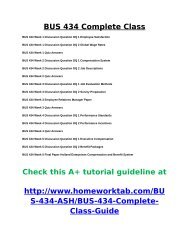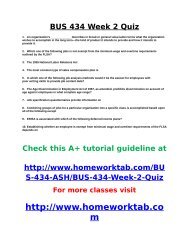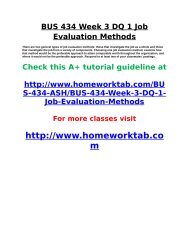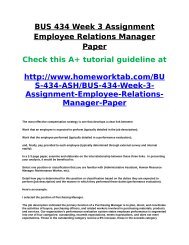ABS 497 Week 5 Final Paper
Create successful ePaper yourself
Turn your PDF publications into a flip-book with our unique Google optimized e-Paper software.
<strong>ABS</strong> <strong>497</strong> <strong>Week</strong> 5 <strong>Final</strong> <strong>Paper</strong><br />
To purchase this material click below<br />
link<br />
http://www.homeworktab.com/<strong>ABS</strong>-<br />
<strong>497</strong>/<strong>ABS</strong>-<strong>497</strong>-<strong>Week</strong>-5-<strong>Final</strong>-<strong>Paper</strong><br />
<strong>Final</strong> <strong>Paper</strong><br />
For more classes visit<br />
www.homeworktab.com<br />
To complete the following final paper,<br />
go to this week's <strong>Final</strong> <strong>Paper</strong> link in<br />
the left navigation.<br />
<strong>Final</strong> <strong>Paper</strong><br />
Focus of the <strong>Final</strong> <strong>Paper</strong><br />
Imagine that you are a researcher<br />
and are conducting a study to<br />
investigate a community problem.<br />
Using behavioral research principles,<br />
select a macro systems problem to<br />
investigate (there are many<br />
suggested in the textbook, e.g.
domestic violence, homophobia,<br />
sexual abuse, delinquent gangs) and<br />
design a study to solve this<br />
community problem.<br />
The purpose of your <strong>Final</strong> <strong>Paper</strong> is to<br />
solve this community problem.<br />
The <strong>Final</strong> <strong>Paper</strong> should be eight- toten<br />
pages (excluding title and<br />
reference pages) that includes the<br />
following components:<br />
(Please note that for the purposes of<br />
offering instruction, examples have<br />
been given below about a research<br />
study involving the use of financial<br />
reward programs to combat truancy.<br />
Please make sure that you create a<br />
study that does not investigate the<br />
same content.)<br />
I. Introduction – This section should<br />
include a brief summary of the<br />
community problem that will be<br />
addressed, as well as the approach<br />
that will be used to investigate and<br />
solve the problem.
II. Statement of the problem – The<br />
purpose of this section is to specify<br />
the main research question (e.g.,<br />
Does enrollment in a financial reward<br />
program reduce truancy?) and define<br />
the community problem in more<br />
depth (e.g., truancy), analyzing why<br />
it is a problem. In addition, you will<br />
explain the problem-solving method<br />
you plan to employ (e.g., enrollment<br />
in a financial reward program) and<br />
state your main hypothesis. (e.g.,<br />
Enrollment in a financial reward<br />
program is expected to reduce<br />
student truancy in the short term,<br />
but its long-term effects are difficult<br />
to predict.)<br />
III. Literature Review – In this section,<br />
research findings pertaining to both<br />
the community problem and problem<br />
solving method need to be<br />
illustrated. (e.g., Relevant articles<br />
may include those on the prevalence<br />
of truancy, the impact of truancy,<br />
previous methods used to combat<br />
truancy, and the benefits of financial<br />
reward programs.)
IV. Methodology – Explain how your<br />
<strong>Final</strong> <strong>Paper</strong> will investigate the<br />
problem. How will the study be<br />
designed? How many participants will<br />
be involved in the study and how will<br />
they be recruited? (e.g., Four classes<br />
at a local high school will be given<br />
the opportunity to participate in the<br />
research study. Two of these classes<br />
will be enrolled in the financial<br />
reward program.) How will data be<br />
collected? (e.g., Truancy data will be<br />
collected on all of the participants for<br />
the six months preceding the reward<br />
program, for the duration of the<br />
program, and for the six months after<br />
completion of the reward program.)<br />
What statistics will be used to<br />
evaluate the data? (e.g., Inferential<br />
statistics will be conducted to<br />
compare the truancy levels of the<br />
group of students participating in the<br />
program with those of the group of<br />
students who are not participating in<br />
the program.) Ethical considerations<br />
should be discussed to ensure that no<br />
unethical research is suggested.
V. Conclusions – This section should<br />
contain concluding remarks about<br />
any potential problems that might be<br />
encountered in conducting this<br />
research study. It should also include<br />
speculations on the potential results<br />
of the study.<br />
Writing the <strong>Final</strong> <strong>Paper</strong><br />
The <strong>Final</strong> <strong>Paper</strong>:<br />
1. Must be eight to ten double-spaced<br />
pages in length, and formatted<br />
according to APA style as outlined in<br />
the Ashford Writing Center.<br />
2. Must include a title page with the<br />
following:<br />
a. Title of paper<br />
b. Student’s name<br />
c. Course name and number<br />
d. Instructor’s name<br />
e. Date submitted
3. Must begin with an introductory<br />
paragraph that has a succinct thesis<br />
statement.<br />
4. Must address the topic of the<br />
paper with critical thought.<br />
5. Must end with a conclusion that<br />
reaffirms your thesis.<br />
6. Must use at least five scholarly<br />
sources, including a minimum of<br />
three from the Ashford Online<br />
Library.<br />
7. Must document all sources in APA<br />
style, as outlined in the Ashford<br />
Writing Center.<br />
8. Must include a separate reference<br />
page, formatted according to APA<br />
style as outlined in the Ashford<br />
Writing Center.

















